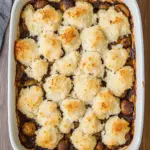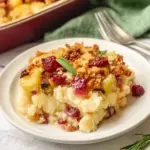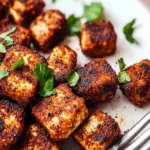This authentic Moroccan couscous is a flavorful and colorful dish, made with perfectly cooked couscous, tender lamb, a variety of stewed vegetables, and a savory broth. Traditionally made every Friday in Morocco, this recipe is a tribute to family gatherings and shared meals. The process may take a little time, but the result is a truly satisfying dish that carries a rich, comforting taste.
Full Recipe:
Ingredients
For the Couscous:
-
2 1/2 cups water
-
1 tsp olive oil
-
2 cups couscous
For the Stew:
-
1 tbsp olive oil
-
1 lb lamb shank or shoulder, cut into chunks
-
2 tsp salt
-
1 tsp pepper
-
2 tsp ginger
-
3 threads of saffron (bloomed with an ice cube)
-
2 tsp paprika
-
1 yellow onion, diced
-
1 carrot, cubed
-
1 small eggplant, chopped into large chunks
-
2 zucchini, chopped into large chunks
-
1 cup chopped turnip, parsnip, or daikon, chopped into large chunks
-
2 tbsp parsley, minced
-
2 tbsp cilantro, minced
-
14oz can of tomato sauce
-
2 cups water or vegetable broth
-
1 tsp pepper flakes or jalapeño pepper
-
1 can garbanzo beans, drained
Directions
-
Prepare the Couscous:
In a medium pot, bring the water and olive oil to a boil. Add the couscous, cover, and remove from the heat. Let sit for 5 minutes, then fluff with a fork and set aside. -
Brown the Lamb:
In a separate large pot, heat olive oil over medium heat. Brown the lamb chunks on all sides. Add the onion, bloomed saffron, and seasonings (ginger, paprika, salt, and pepper). Sauté until the onion is translucent. -
Add the Veggies:
Toss in the cubed carrots and root vegetables. Cook for a couple of minutes, then add the zucchini, eggplant, and continue sautéing for a couple of minutes more. -
Add the Broth:
Add the minced parsley and cilantro, tomato sauce, and water (or vegetable broth). Cook over medium heat, slightly covered, until all the vegetables are tender and the lamb reaches an internal temperature of 145°F (about 20 minutes). -
Finish the Stew:
Add the garbanzo beans and mix thoroughly. Continue to cook until the beans are heated through. -
Serve:
To serve, plate the couscous first, then top with the stewed lamb and vegetables. Pour the broth over the top and garnish with additional parsley and cilantro.
Nutrients
(Approximate values per serving)
-
Calories: 450 kcal
-
Total Fat: 20g
-
Saturated Fat: 5g
-
-
Cholesterol: 65mg
-
Sodium: 800mg
-
Total Carbohydrates: 45g
-
Fiber: 7g
-
Sugars: 8g
-
-
Protein: 28g
-
Vitamin D: 0mcg
The Importance of Couscous in Moroccan Cuisine
Couscous is a staple in Moroccan cuisine and holds a central place in the country’s culinary traditions. Made from semolina wheat, couscous has a light, fluffy texture that absorbs the flavors of whatever it is paired with, making it the perfect base for stews, meats, and vegetables. While couscous is often served as a side dish, in Morocco, it is commonly used as the main component of a hearty meal, especially when served with lamb, vegetables, and a rich broth. The versatility of couscous allows it to absorb the deep flavors of the stews and sauces, while its texture offers a pleasant contrast to the tender meat and vegetables. Moroccan couscous is typically prepared by steaming, which gives it its delicate and airy texture.
The Stew: A Flavorful Fusion of Spices and Tender Meat
The stew that accompanies the couscous is the heart of this dish. Moroccan stews, or “tagines,” are known for their complex and aromatic flavors, often achieved by the combination of spices, herbs, and slow-cooked meats. In this recipe, lamb is used as the main protein, and it’s cooked until it’s fall-apart tender. The choice of lamb in Moroccan cuisine is traditional, as it is often used for its rich flavor and tender texture when slow-cooked. The lamb is seasoned with a blend of spices such as ginger, saffron, paprika, and pepper, which contribute to the depth of flavor and warmth that define Moroccan cuisine.
The saffron, a prized spice known for its distinct flavor and vibrant yellow color, adds a subtle earthy richness to the dish. Ginger and paprika further enhance the stew, providing a balance of warmth and smokiness. The use of ginger is particularly significant in Moroccan cooking, where it adds a fragrant and slightly spicy flavor to dishes. As the lamb and vegetables simmer in the broth, these spices infuse the entire dish, creating a complex flavor profile that is both savory and aromatic.
A Rainbow of Vegetables
In addition to the lamb, this couscous dish is enriched with a variety of vegetables, each contributing its unique texture and flavor. Carrots, zucchini, eggplant, and turnips are common in Moroccan stews, and they are all chosen for their ability to absorb the rich flavors of the broth while maintaining their individual characteristics. The carrots add a mild sweetness, while the zucchini and eggplant contribute a soft, tender texture that contrasts nicely with the more robust flavors of the lamb.
The turnips or parsnips bring an earthy, slightly peppery flavor to the dish, balancing the sweetness of the other vegetables. The combination of these vegetables not only makes the stew visually vibrant but also adds layers of taste that harmonize with the savory broth. Together, these ingredients create a dish that is both hearty and healthy, filled with a variety of nutrients and textures.
The Role of Chickpeas and Fresh Herbs
Chickpeas, or garbanzo beans, are often added to Moroccan stews to provide additional texture and protein. Their mild, nutty flavor and firm texture make them the perfect addition to the dish, as they absorb the flavors of the stew and add a bit of bite to each spoonful. Chickpeas are a common ingredient in Moroccan cooking, valued for their ability to complement both meat and vegetable dishes.
Fresh parsley and cilantro are used throughout the dish, adding a burst of freshness that cuts through the richness of the stew and lamb. These herbs are often used in Moroccan cuisine to brighten up the flavors of a dish and to provide a contrasting freshness to the savory elements. The parsley and cilantro are added both during the cooking process and as a garnish, offering layers of aromatic freshness that balance the warmth of the spices and the richness of the meat.
The Savory Broth: Rich and Comforting
The broth in this dish is one of the key components that bring all the flavors together. Made from the juices released by the lamb and vegetables as they cook, the broth is enriched with spices and seasonings that enhance its flavor. The use of saffron, ginger, paprika, and garlic gives the broth a rich, fragrant quality, while the slow cooking process allows the flavors to meld together into a deeply savory and satisfying base. The broth absorbs the flavors of the lamb, vegetables, and spices, creating a flavorful liquid that complements the couscous and ties the entire dish together.
For an added depth of flavor, the broth is often made with vegetable stock or water, which allows the natural flavors of the lamb and vegetables to shine through. This broth is poured over the couscous before serving, allowing the grains to absorb its flavors and become tender, ensuring that each bite is full of richness and complexity.
The Preparation Process: A Labor of Love
While this recipe requires some time and effort, the result is a dish that is well worth the investment. The slow cooking process allows the lamb to become incredibly tender, while the spices have time to infuse every element of the dish. The couscous itself is relatively simple to prepare, but the stewing process requires patience, as the vegetables and lamb need to cook for a while to develop their full flavor.
In traditional Moroccan households, this dish is often made as part of a communal meal, where family members gather around the table to enjoy the food together. The process of cooking and sharing the dish is as important as the meal itself, and it reflects the strong sense of community and togetherness that is central to Moroccan culture. Making Moroccan couscous is a labor of love, and the result is a deeply satisfying and flavorful dish that brings people together.
Serving Moroccan Couscous: A Feast for the Senses
Once the couscous and stew are ready, the dish is served by plating the couscous first and then topping it with the stewed lamb and vegetables. The rich, flavorful broth is poured over the top, allowing the couscous to absorb the savory liquids and become tender and flavorful. The final touch is a garnish of fresh parsley and cilantro, which adds a burst of color and a refreshing contrast to the richness of the dish.
Moroccan couscous is traditionally served with flatbread or crusty bread, which can be used to scoop up the couscous and stew. The dish is often accompanied by traditional Moroccan salads, which are light and refreshing, providing a balance to the richness of the couscous. A glass of Moroccan mint tea, known for its sweet and fragrant qualities, is the perfect beverage to pair with this dish, completing the meal in true Moroccan style.
Conclusion
In conclusion, authentic Moroccan couscous with lamb and vegetables is a truly satisfying dish that combines rich flavors, aromatic spices, and fresh ingredients to create a comforting meal. The tender lamb, hearty vegetables, and perfectly cooked couscous all come together in a flavorful stew that is as much about the cooking process as it is about the meal itself. This dish is a tribute to the Moroccan tradition of communal dining and shared meals, and it’s a wonderful way to bring people together around the table. Although it requires some time and effort, the result is a deeply flavorful and fulfilling dish that captures the essence of Moroccan cuisine. Whether made for a special occasion or enjoyed as part of a regular family meal, Moroccan couscous is a dish that is sure to impress and satisfy anyone who tastes it.






